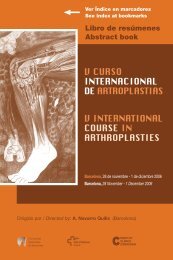Notas / Notes - Active Congress.......
Notas / Notes - Active Congress.......
Notas / Notes - Active Congress.......
You also want an ePaper? Increase the reach of your titles
YUMPU automatically turns print PDFs into web optimized ePapers that Google loves.
VIERNES / FRIDAY<br />
192<br />
and synovial attachments to the bone. When this lateral<br />
tightness is associated with internal rotational contracture, the<br />
popliteus tendon attachment to the femur also is released.<br />
The iliotibial band and lateral posterior capsule should not be<br />
released in this situation because they provide lateral stability<br />
only in extension.<br />
TIGHT LATERALLY IN FLEXION AND EXTENSION<br />
The only structures that provide passive stability in flexion are<br />
the LCL and the popliteus tendon complex, so knees that are<br />
tight laterally in flexion and extension have popliteus tendon<br />
or LCL release (or both). Stability is tested after adjusting tibial<br />
thickness to restore ligament tightness on the lateral side of<br />
the knee. Additional releases are done only as necessary to<br />
achieve ligament balance. Any remaining lateral ligament<br />
tightness usually occurs in the extended position only, and is<br />
addressed by releasing the iliotibial band first, then the lateral<br />
posterior capsule if needed. The iliotibial band is approached<br />
subcutaneously and released extrasynovially, leaving its<br />
proximal and distal ends attached to the synovial membrane.<br />
TIGHT LATERALLY IN EXTENSION ONLY<br />
In knees that initially are too tight laterally in extension, but<br />
not in flexion, the LCL and popliteus tendon are left intact,<br />
and the iliotibial band is released. If this does not loosen the<br />
knee enough laterally, the lateral posterior capsule is released.<br />
The LCL and popliteus tendon rarely, if ever, are released in<br />
this type of knee.<br />
Finally, the tibial component thickness is adjusted to achieve<br />
proper balance between the medial and lateral sides of the<br />
knee. Anteroposterior stability and femoral rollback are assessed,<br />
and posterior cruciate substitution is done if necessary<br />
to achieve acceptable posterior stability.<br />
LONG TERM CLINICAL EXPERIENCE WITH<br />
CRUCIATE RETAINING TKA<br />
Jorge O. Galante, MD.<br />
Rush Arthritis & Orthopaedic Institute St. Luke’s Medical<br />
Center. Illinois (USA)<br />
Design rationale in PCL retaining devices should include:<br />
asymmetric femoral condyles, ability to reproduce the AP<br />
dimensions of the femur, relatively flat unconstrained tibial<br />
articulating surfaces, and a slope of 7 degrees on the tibial<br />
cut. Preservation of bone stock is possible both in the femur<br />
and in the tibia. The use of four small pegs in the tibial component<br />
instead of a stem allows for limited intrusion on the<br />
upper end of the tibia.<br />
A critical issue is the tension in the posterior cruciate ligament,<br />
a function of prosthetic design as outlined above and surgical<br />
technique. We recommend the use of measured resection<br />
technique and instrumentation. The possibility of restoring<br />
the AP dimensions of the femur within 1 mm. makes restoration<br />
of the flexion gap an easy task. In more contemporary designs,<br />
improved kinematics at the patellofemoral joint and high<br />
flexion designs provide additional valuable features to minimize<br />
patellofemoral complications and improve the range of motion.<br />
We have reported excellent long term results our first and<br />
second generation designs. Our experience showed excellent<br />
fixation with no loosening and no osteolysis at 15 years. Late<br />
instability was not a problem.<br />
We evaluated implant survivorship, reoperation rates, and<br />
complication rates of a group of patients who had total knee<br />
arthroplasty with a third-generation cemented cruciate-retaining<br />
design at 10 to 12 years follow up.<br />
One hundred and eighty six consecutive primary total knee<br />
arthroplasties were performed at our institution during a 2year<br />
period. Kaplan Meier survivorship using revision for any<br />
reason as endpoint was 98% at 10 years. Three patients required<br />
revision. One for deep infection, one for a periprosthetic<br />
fracture and one for arthrofibrosis. No patients had reoperation<br />
for problems related to the patellofemoral joint. Our results<br />
show that with appropriate patient selection and meticulous<br />
attention to surgical technique, excellent clinical and radiographic<br />
results can be achieved.<br />
The high prevalence of patellofemoral complications with the<br />
original design was obviated by changes in the shape of the<br />
patellofemoral articulation.<br />
Cruciate retaining designs can provide excellent long-term<br />
function when the appropriate design and surgical technique<br />
are used.<br />
FEMORAL COMPONENT POSITIONING IN<br />
TKA. A 3-D PROBLEM<br />
J. David Blaha, Ann Arbor<br />
University of Michigan Medial School,<br />
Michigan (USA)<br />
Placing total knee components in the proper position in all<br />
three planes (frontal, sagittal and transverse) is important for<br />
correct functioning of the arthroplasty. Until relatively recently<br />
little attention has been paid to positioning in the transverse<br />
plane – often referred to as the “rotational” position of components.<br />
There has been acceptance of the transepicondylar<br />
axis (TEA) is a landmark by which the surgeon can align the<br />
femoral component of a total knee replacement to achieve<br />
proper rotation. Surgeons have experienced problems, however,<br />
finding the epicondyles with certainty making this set<br />
of landmarks difficult to use, and there is some concern that<br />
the epicondyles do not always define a kinematically proper<br />
placement. A line down the trochlear groove (AP axis – most





